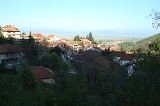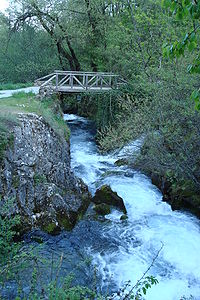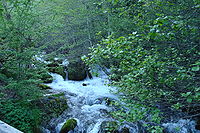
Vevcani
Encyclopedia


Republic of Macedonia
Macedonia , officially the Republic of Macedonia , is a country located in the central Balkan peninsula in Southeast Europe. It is one of the successor states of the former Yugoslavia, from which it declared independence in 1991...
. It is the only settlement and seat of Vevčani Municipality
Vevcani municipality
Vevčani is a municipality in western Republic of Macedonia. Vevčani is also the name of the municipal seat and the only settlement of the municipality...
.
Geography
The village of Vevčani is found in the southwestern range at the foot of the JablanicaJablanica, Republic of Macedonia
Jablanica is a mountain in Albania and the Republic of Macedonia, located along the border between both countries. The long mountain ridge is higher than for approximately , while the highest part, located in its very center, is Black Stone at high. Both countries have 50% of the mountain,...
mountain range. It is situated from 800 – 950 metres above sea level. The village is located 14 km North-West of the town of Struga
Struga
Struga is a town and popular tourist destination situated in the south-western region of the Republic of Macedonia, lying on the shore of Lake Ohrid. The town of Struga is the seat of Struga Municipality.-Etymology:...
. The village is situated near the villages of Oktisi, Velešta, Podgorci
Podgorci
Podgorci is a village to the west of Velika Nedelja in the Ormož Municipality in northeastern Slovenia. The area traditionally belonged to the Styria region and is now included in the Podravska statistical region....
, Gorna Belica with the Albania
Albania
Albania , officially known as the Republic of Albania , is a country in Southeastern Europe, in the Balkans region. It is bordered by Montenegro to the northwest, Kosovo to the northeast, the Republic of Macedonia to the east and Greece to the south and southeast. It has a coast on the Adriatic Sea...
n border to the West of the village.
Vevčani Springs
The famous Vevčani springs are some of the most famous springs to be found in the Republic of MacedoniaRepublic of Macedonia
Macedonia , officially the Republic of Macedonia , is a country located in the central Balkan peninsula in Southeast Europe. It is one of the successor states of the former Yugoslavia, from which it declared independence in 1991...
. The springs are located on the eastern slope of the Jablanica mountain range which run through the village of Vevčani at an approximately sea level altitude at over 900 metres. The largest spring is located at the opening of one of the many caves in the region. Below the largest spring are ten minor springs which all converge together. The most famous spring is "Jankov Kamen" which is situated at 1200 metres above sea level. Another spring is "Mala Livada" from which the water has a unique flavour and colour. It is situated at over 1600 metres above sea level. The highest spring is "Golina" situated at over 2000 metres above sea level. The rate of water flow from the springs is estimated to exceed the rate of 1500 litres per second, most notably in Spring.
Vevčani Lakes
Within the vicinity of the village of Vevčani there are many glacial lakes. The highest and mot prominent glacial lake is "Lokva" which is situated at over 2000 metres above sea level on Mount Jablanica. It is the main provider of water to the "Golina" spring.Etymology
The word "Vevčani" is based on an Old Church SlavonicOld Church Slavonic
Old Church Slavonic or Old Church Slavic was the first literary Slavic language, first developed by the 9th century Byzantine Greek missionaries Saints Cyril and Methodius who were credited with standardizing the language and using it for translating the Bible and other Ancient Greek...
word. The word Ves which meant village in Old Church Slavonic. The word Vesčani meant in Old Church Slavonic, "people of Ves" or "Vesians". This soon became the name of the settlement. By the 14th the name "Veščani" was being used. In 17th century records the village is referred to Veščano (Вешчано). By the early 20th century the village was often referred to as Vehčani (Вехчани) or Vesčani (Весчани), until the name Vevčani was officially adopted. The village is also known as Veçani in Albanian
Albanian language
Albanian is an Indo-European language spoken by approximately 7.6 million people, primarily in Albania and Kosovo but also in other areas of the Balkans in which there is an Albanian population, including western Macedonia, southern Montenegro, southern Serbia and northwestern Greece...
and Vevčani in both Serbian
Serbian language
Serbian is a form of Serbo-Croatian, a South Slavic language, spoken by Serbs in Serbia, Bosnia and Herzegovina, Montenegro, Croatia and neighbouring countries....
and Bulgarian
Bulgarian language
Bulgarian is an Indo-European language, a member of the Slavic linguistic group.Bulgarian, along with the closely related Macedonian language, demonstrates several linguistic characteristics that set it apart from all other Slavic languages such as the elimination of case declension, the...
.
Early History
It is believed that the village of Vevčani was founded sometime during period from the end of the 6th century to the beginning of the 8th century. The village was founded most probably by Berziti, who had adopted Christianity. The first settlement was originally at the foot of the Jablanica mountain. It was believed to have been founded in a place known as Selište (Old Church SlavonicOld Church Slavonic
Old Church Slavonic or Old Church Slavic was the first literary Slavic language, first developed by the 9th century Byzantine Greek missionaries Saints Cyril and Methodius who were credited with standardizing the language and using it for translating the Bible and other Ancient Greek...
: Сєлиштє).
After the Balkan Wars
After the Balkans Wars the village of Vevčani fell under Serbian rule. It was a part of the Vardar BanovinaVardar Banovina
The Vardar Banovina or Vardar Banate or Vardarska Banovina was a province of the Kingdom of Yugoslavia between 1929 and 1941. It was located in the southernmost part of the country, encompassing the whole of today's Republic of Macedonia, southern parts of Central Serbia and southeastern parts of...
before it was captured during the Invasion of Yugoslavia
Invasion of Yugoslavia
The Invasion of Yugoslavia , also known as the April War , was the Axis Powers' attack on the Kingdom of Yugoslavia which began on 6 April 1941 during World War II...
by Albanian forces
Balli Kombëtar
Balli Kombëtar was an Albanian nationalist, anti-communist and anti-monarchy organization established in October 1939. It was led by Ali Këlcyra and Mit’hat Frashëri...
. The name of the village was officially changed to Veçani. A group of partisans was created in Vevčani on 17 September 1944. The group liberated the village as a part of the "Drimkol" group of partisans.
Under Communist rule
In 1945 the village of Vevčani became a part of the newly founded People's Republic of MacedoniaSocialist Republic of Macedonia
The Socialist Republic of Macedonia was a socialist state that was a constituent country of the former Socialist Federal Republic of Yugoslavia...
. In 1945 the municipality of Vevčani was founded which included the nearby villages of Oktisi and Gorna Belica. This was dissolved in 1952 as Vevčani became a part of the Velešta municipality until 1956. In 1956 it was merged with the Struga Municipality.
Vevčani Emergency
The Vevčani Emergency was an incident which occurred in the village on 26 May and 7 August 1987. The residents of Vevčani defied the decision of the Yugoslavian government to redirect water from the springs to Struga. They were at odds with the government's attempts to have the inhabitants of Struga using what they saw as their water. Police were assembled twice in the village before the situation was resolved. The residents had sparked calls for democracy and freedom from the Yugoslavia government. A "Republic of Vevčani" had been planned by the residents.Republic of Vevčani and the Vevčani Ličnik
After the fall of Communism, as a bid to attract more tourism to the town the residents of Vevčani voted to create an independent republic in the town. The "Republic of Vevčani" was soon founded.As a part of the self-styled "Independent Republic of Vevčani" declared in 2002, the "Vevčani Ličnik" was created as souvenir currency for the area. The "Ličnici" (plural) come in denominations of 1, 2, 5, 10, 50, 100, 500 and 1,000. The author was artist Simun Lesoski.
Municipality of Vevčani
In 2002 the Vevčani municipalityVevcani municipality
Vevčani is a municipality in western Republic of Macedonia. Vevčani is also the name of the municipal seat and the only settlement of the municipality...
was founded. The reconstituted municipality included only the village of Vevčani.
Culture
Vevčani is known for being a hub of culture and history in the Drimkol region. Along with Old Architecture and many preserved churches from the 17th and 18th centuries.Vevčani Carnival
One of the most famous village festivals held in the Balkans is the Vevčani Carnival . It is believed that the custom is over 1,400 years old. It is based on old Pagan beliefs and rituals. Essentially the Carnival is the ritual of calling after Saint Basil the Great, which coincides with the Twelve Days of Orthodox Christmas and the Orthodox New Year. The festivity is held on the 13th and 14 January every year and is dedicated to Saint Basil the GreatBasil of Caesarea
Basil of Caesarea, also called Saint Basil the Great, was the bishop of Caesarea Mazaca in Cappadocia, Asia Minor . He was an influential 4th century Christian theologian...
. The Carinval witnesses the passing of the old year and the coming of the new one. The participants of the Carnival are known as Vasiličari . In 1993 the Carnival and the village of Vevčani officially became apart of the World Federation of Carnival Cities. In recent years a special "Carnival Passport" has been issued at the Carnival.
Green Agenda
The process of creating the GA document in Macedonia began in August 2007, with the election of the municipality of Vevcani as one of the 3 pilot municipalities in Macedonia where the GA will be implemented.The process of creating the GA of Vevcani is very broad, based on the work of the wide community and involves citizens that participate in the creating of the document and by doing that they influence on the decision making process in the community.
For the first time in Macedonia, the citizens have the opportunity directly to influence the process of decision making, to create partner relations with the local government and business sector in order to achieve benefits for the community.
http://www.greenagenda.net
Religion
Vevcani is home to the "Parish of Vevčani" which also includes the villages of Oktisi and Gorna Belica. For centuries the village has been a Christian village surrounded by many Muslim villages. The village is home to 19 Churches, Monasteries and Chapels. The central church of the village however is Saint Nikola which dates back from 1876. A prominent monastery is Sveti Spas which is situated at over 1300 metres above sea level.Vevčani-Radožda dialect
The inhabitants of Vevčani speak a unique a dialect of Macedonian which is known as the Vevčani-Radožda dialect. The dialect is traditionally spoken in three other villages along with Vevčani. They are RadoždaRadožda
Radožda is a village in the Struga municipality in the southwestern region of the Republic of Macedonia.-Geography:Radožda is situated on the western shore of the Ohrid Lake. It is south of the town Struga. It is from the Macedonian-Albanian border crossing Ćafa San. The closest village is the...
and Mali Vlai along with the village of Lin
Lin, Korçë
Lin is a village in Pogradec District, Korçë County, Albania.-Demography:Lin is home to an officially unrecognised Macedonian Christian majority population and an Albanian Muslim minority population.-Dialect:...
in Albania.
Demographic history
In 1634 the village was listed as a having a non-Muslim population. It was listed as being a part of the OhridOhrid
Ohrid is a city on the eastern shore of Lake Ohrid in the Republic of Macedonia. It has about 42,000 inhabitants, making it the seventh largest city in the country. The city is the seat of Ohrid Municipality. Ohrid is notable for having once had 365 churches, one for each day of the year and has...
vilayet under the name Vevčano with a total of 134 houses in the village. The French ethnographic study of Macedonia conducted in 1878, Ethnography of the vilayets of Adrianople, of Monastir and of Salonica, , counted the village as having 865 houses and 2430 inhabitants, which at the time were considered Bulgarians. Vasil Kanchov
Vasil Kanchov
Vasil Kanchov was a Bulgarian geographer, ethnographer and politician.- Biography :Vasil Kanchov was born in Vratsa. Upon graduating from High school in Lom, Bulgaria, he entered the University of Harkov, then in Russia. During the Serbo-Bulgarian War 1885 he suspended his education and took part...
's study of Macedonia in 1900, Macedonia, Ethnography and Statistics, , counted the village as having 2590 Bulgarian inhabitants. A study conducted in 1907 had counted 440 households with 2,347 inhabitants. The 1994 census counted 2,448 inhabitants as residing in the village.
Demographics today
According to the 2002 Macedonian census the population of Vevčani was 2,433. In 2002 there were 593 househlds present in Vevčani. Of the 2,433 inhabitants, 1,229 were Males while 1,204 were females. The ethnic composition was as follows:- MacedoniansMacedonians (ethnic group)The Macedonians also referred to as Macedonian Slavs: "... the term Slavomacedonian was introduced and was accepted by the community itself, which at the time had a much more widespread non-Greek Macedonian ethnic consciousness...
- 2,419 (99.4%) - AlbaniansAlbaniansAlbanians are a nation and ethnic group native to Albania and neighbouring countries. They speak the Albanian language. More than half of all Albanians live in Albania and Kosovo...
- (0.%) - AromaniansAromaniansAromanians are a Latin people native throughout the southern Balkans, especially in northern Greece, Albania, the Republic of Macedonia, Bulgaria, and as an emigrant community in Serbia and Romania . An older term is Macedo-Romanians...
- 1 (0.04%) - SerbsSerbsThe Serbs are a South Slavic ethnic group of the Balkans and southern Central Europe. Serbs are located mainly in Serbia, Montenegro and Bosnia and Herzegovina, and form a sizable minority in Croatia, the Republic of Macedonia and Slovenia. Likewise, Serbs are an officially recognized minority in...
- 3 (0.1%) - bulgarien - 0 (0%)
- Others - 7 (0.28%)
Sport
The football team "FK Vevčani" is based in Vevčani. The team is a competitor in the Macedonian Treta LigaMacedonian Treta Liga
The Macedonian Third League is the third highest football competition in the Republic of Macedonia.The competition is divided into five divisions named Third League - North , Third League - South , Third League - East , Third League - West and Third League - Southeast The Macedonian Third League ...
.
Notable people
- Jovan Popovski - pisatel,journalist,eseist
- Dimce Partaloski- advokate,author of the Dictionary vevcanski (1998,2009)
- Milutin Bebekoski- pisatel
- Jakim Alulov, (? - 1903) - revoloutionary and voivode
- Stavre Gogov, (1884 - 1907) - voivode from Vevčani
- Pero Ilieski-Mayor of Vevcani
- Simun Lesoski-artist

